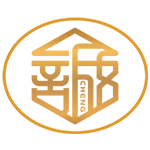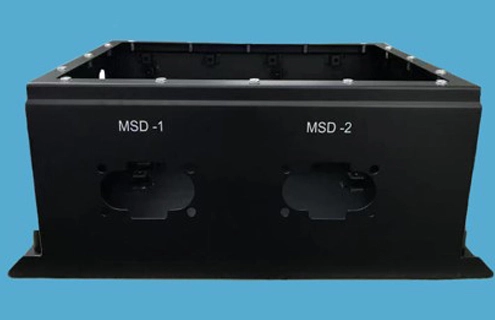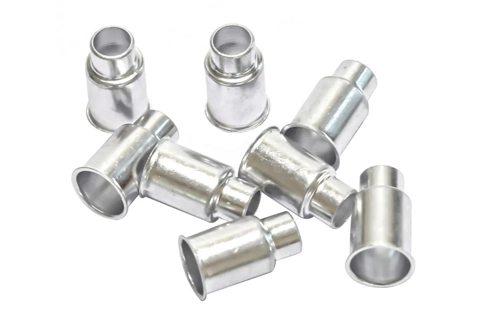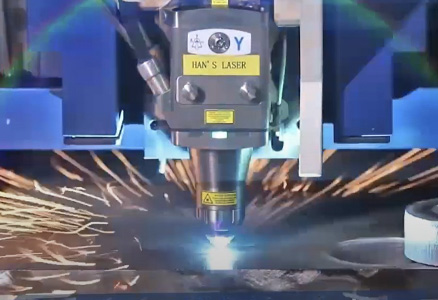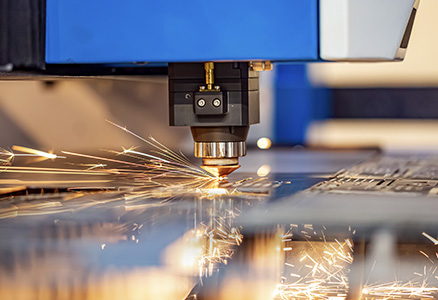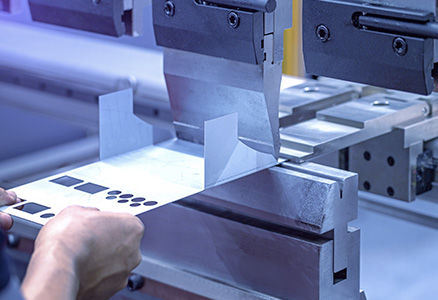Metal stamping is the most used sheet metal forming process, if you are looking into related technical information and want to find the best solution to handle it, you absolutely ought to read this important article.
What is Metal Stamping
Metal stamping is a commonly used metal forming process that consists of three elements: a press, a mold and a metal material. The press provides power to transfer the shapes processed by the mold to various metal sheets you placed in. The metal sheets deform and extend through the pressure until you close the mold completely.
History of Metal Stamping
When you search for the origin of metal stamping and fabrication, it probably first used to make gold or silver coins. The Lydians in west Asia began to use this technology in the seventh century BC in earliest records. In 1550, the German craftsman Max Schwab, who used a screw press to provide pressure for metal fabrication to improve production efficiency.
As you may know that steam engines as a new source of power were invented in the Industrial Revolution, German bicycle manufacturers began to use mechanical presses to produce metal parts for bicycles in the late 1800s. Later on, Henry Ford developed the metal stamping process in the modern sense and the precision and tolerances were constantly improving. The two world wars and the wave of globalization have also promoted large-scale applications.
Until today, metal stamping is used in various industries, including the military industry. aerospace, automobiles, electronics, agriculture, medical care, etc.
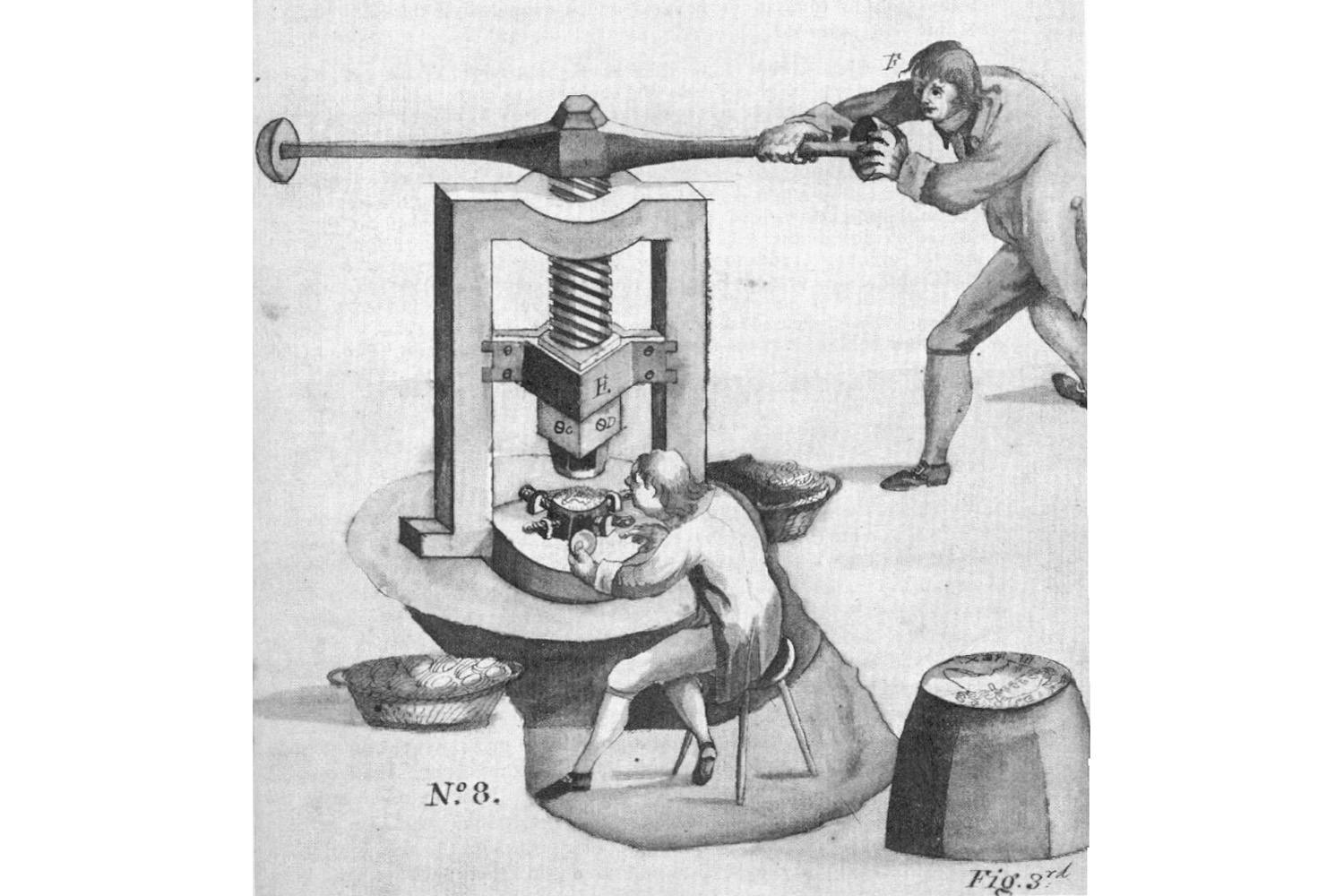
Figure 1 screw press on coin pressing
Why We Need Metal Stamping
Here are some ideas from JCLDD sheet metal fabrication manufacturer about deep draw manufacturing, The most commonly used metal manufacturing processes include casting, forging and stamping. Metal stamping has existed for thousands of years, especially when you process metal sheets. Casting is a phase change process in which metal is heated beyond its melting point and the molten liquid is cooled into a solid state. Forging is a 3D metal forming. You can put extremely high pressure on the metal block and press the mold features onto the material. Stamping is a form of molding that changes from 2D to 3D in a sense. The flat metal sheet enters your mold and is drawn and stretched, changing from a flat surface to a 3D curved surface.
Stamping is a basic process where you can use limited equipment and labor to greatly improve production and manufacturing costs. It is as important as casting and forging, and is one of your indispensable metal forming processes.
Types of Metal Stamping
Metal stamping can be categorized in various ways, and we will show you a few common methods of classification and their industrial metal stamping.
Process Temp.: Hot Stamping & Cold Stamping
If you heat metal sheets to different temperatures before forming, it has different effects on the strength, formability and processing parameters of the finished product.
Your metal sheet is heated above the melting point in advance, and the microstructure of the metal crystal changes from low-temperature ferrite and pearlite to austenite. Your material becomes softer and more ductile and is easier to be pressed into complex shapes. While transferred to the mold and rapidly cooled, your material undergoes phase deformation inside the mold to form martensite. As you know, martensite crystal is a very hard and high-strength microstructure, which will greatly improve your material after cooling. Your rapid heating and cooling change the microscopic crystal structure of the metal to achieve its desired properties. You can use this process for products with complex shapes and high strength, such as aerospace and automotive parts, because they require extremely high strength, hardness and the ability to absorb impact energy.
Cold stamping is different from hot stamping in that there is no such step of heating the material in advance. You transfer the material to the mold at room temperature for pressing. Because the material is not heated, there is naturally no structural change in the microcrystalline. You are testing the mechanical properties of the material itself in the process. It is necessary to calculate the optimal process parameters to avoid the occurrence of defects. Generally speaking, the cold stamping process is simpler, you can have a wider range of applications, and has higher production efficiency. It is a more common stamping process.
Specialized Operations: Four Slides / Deep Drawing / Fine Blanking
Four Slides Stamping, you can tell from its name that it has four sliders. These four slide blocks are driven by the motor on the equipment and are at a 90-degree angle to each other. The power is transmitted to the slide blocks through the transmission of bevel gears and some cam structures. When you start the motor, the power is transmitted from this series of mechanical structures to the sliders, and the four sliders begin to reciprocate. You should note that they start to reciprocate one after another in sequence. Each slider starts to reciprocate. Your mold on the machine will squeeze the material to form an included angle of more than 90 degrees. This fully automatic molding method has high output and repeatability, generally does not require your intervention, and is especially suitable for your products with tetrahedral structure bending.

Figure 2 four slides stamping
Sheet metal Deep drawing is where you make metal shells with a larger height-to-width ratio. The height-to-width ratio is usually around 1:1, but you can do as much as 2:1 or even 3:1. To achieve this, you need to know a lot about different materials and have the right mold designs and process steps. The material is gradually stretched and formed step by step. The material is pulled deeper and deeper and step by step.The molds usually consist of a convex part and a concave part, called punch and die. You insert the material strips into your feeder and then undergo multi-step unidirectional stretching to reach your desired size. You can make electronic or medical parts with less than 1 mm diameter, as well as very large automotive mechanical parts with more than 500 mm.
When you apply Fine Blanking, you tend to focus on making metal parts with particularly high precision and exquisite edges, without emphasizing the forming effect. This process requires particularly high precision for equipment and molds. The equipment has higher tonnage and rigidity, and can release high impact pressure to shear the material in an instant. You should assemble the mold with basically zero clearance to ensure that various parts of the mold will not shift during movement. During the impact process, your material is tightly clamped and has none of displacement.The punch is instantly dropped and cuts the material rapidly. Because of this, the process steps are relatively short, you need less secondary processing, and the costs are relatively low.
Short Run Stamping & Long Run Stamping (Low Volume & High Volume)
Short run stamping is adopted when you produce a smaller batch of goods in a shorter period of time, while long run stamping does the opposite. The table below makes a detailed comparison.
Criteria | Short Run Stamping | Long Run Stamping |
Volume | Less than 1K if small parts Less than 100 if big parts | More than 1K if small parts More than 100 if big parts |
Duration | Rapid production in a limited period of time | Extended production period |
Tooling | Simpler, less expensive tooling. Minimal wear and tear. | Durable, more complex tooling required. Designed for long-term use. |
Flexibility | High flexibility for design changes and modifications | Limited flexibility for changes once production has started |
Cost | Lower tooling costs, higher cost per part due to lower volumes | Higher upfront costs, but lower cost per part due to economies of scale |
Applications | Ideal for prototypes, custom orders, products with frequent changes | Suitable for standardized products with stable designs and high demand |
Low volume and high volume stamping has the similar meaning of short run and long run. The difference might lie in that short-run and long-run stamping tend to focus more on adjustments and optimization during the mold trial. On the other hand, you are more concerned with the stability of production and consistent output in low-volume and high-volume stamping.
Progressive Die Stamping
Progressive Die Stamping and progressive die operation might be the metal stamping method you hear about the most. You can understand it as a collection of various specific metal forming processes. For instance, when the metal coil is fed into the mold by the feeder, it goes through the first processing station – punching. By the time it passes this station, holes are already made. Next, it moves to the second station – bending, where the material with holes is bent into the shape you desire. The third step might be stretching, further extending the shape, and so on. There are positioning holes on the metal material. As it is conveyed by the feeder, these holes align with the guide posts on the mold to ensure precise positioning in every step of the forming process. In this way, by going through a series of processing stations, you get the final product shape you want. Progressive Die Stamping can be said to be one of the most efficient metal stamping processes. Each step is continuously carried out, allowing the production of large quantities of products in a very short time.
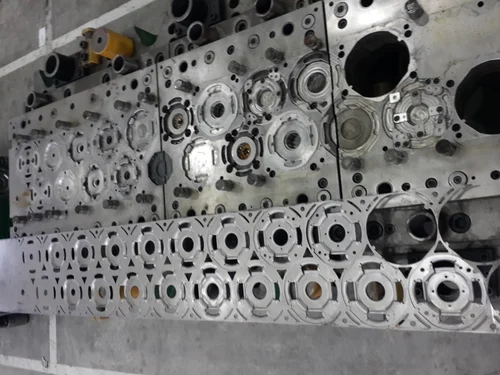
Figure 3 Progressive Die Stamping
Transfer Die Stamping
You can think of Transfer Die Stamping as a processing method similar to Progressive Die Stamping. It too applies a collection of multiple stamping stations to shape the material step by step to get the desired form. However, it differs in a few fundamental ways.
Firstly, it doesn't use an automatic feeder to push the metal strip forward. Instead, the raw material is cut into separate pieces by the previous processes quite early on.
Secondly, these cut pieces, or blanks, are grabbed by a mechanical transfer device, which then moves them from one stamping station to the next. As this happens, new blanks are fed into the stations that the previous blanks have just left.
Thirdly, every time the mechanical transfer device shifts the blanks from one station to another, the mold performs a stamping operation, progressively moving the blanks toward their final form step by step.
Thanks to this method bypassing the need for a material strip in transit, you can significantly reduce material waste. Each piece moves independently between the various molds, providing more flexibility to create complex shapes without the interference that might be caused by the presence of a material strip.
Difference of Metal Stamping and Metal Forming
You might easily get confused between the definitions of Metal Stamping and Metal Forming, but let's clear that up right now.
Broadly speaking, metal stamping is a type of metal forming. With different molds, you can perform actions like punching, cutting, bending, stretching, and flanging. However, remember that all these are done using stamping dies.
Deep draw metal forming, on the other hand, encompasses a lot more than just metal stamping. It includes processes like forging, casting, roll forming, bending, extrusion, powder metallurgy, and so on. It's not limited to one kind of equipment, one type of mold, or one state of raw material. The processing principles vary widely, making it a more general term.
Factors to Consider When Stamping Metal
Material and Thickness
You better understand the material’s properties. The strength, ductility, and thickness of the metal influence the stamping process’s success.
Tooling Details
Examine your die design carefully. It’s not just about dimensions; also consider clearances and how these affect your stamped parts’ accuracy.
Process Parameters
Blank holder force is a critical factor that controls material flow and helps in preventing defects like wrinkling and punch speed can significantly influence the deformation behavior and the quality of your stamped parts.
Maintain optimal temperature. Both the material and the die’s temperature impact formability and the potential for springback.
Friction and Lubrication
Don’t overlook the friction. The contact friction coefficient between the tool and blank is key for longevity of your tools. Proper lubrication can reduce friction, wear, and improve the surface finish of your stamped parts.
Geometrical Influence
Pay attention to the drawbead height and die radius. These geometric factors dictate material flow and influence the drawing operation. Understanding springback is to ensure that your final product retains the desired shape and dimensions. Preventing ironing, galling, and tearing is crucial for the quality of your stamped parts.
Advanced Techniques
If you’re diving into finite element simulations or using advanced tools, make sure every detail, from mesh size to punch speed, is meticulously set.
By following these guidelines, you ensure a smoother process, resulting in high-quality stamped metal parts.
What are Applications of Metal Stamping
Metal stamping parts are some of the most easily found components in products across various industries; you can almost find their presence in every type of industrial product. From something as small as a connector's joint to something as large as an airplane's shell, they can be manufactured in a variety of material shapes, features, and functional uses. Next, I will walk you through the various applications of metal stamping.
Automotive Parts:
Regardless of the type of vehicle, automotive metal stamping parts, its structural components and main appearance parts are composed of metal stamping parts. For example, body panels for doors, hoods, and fenders, valve covers, connecting rods for engines, transmission components like clutch plates and housings, electrical connectors and terminals, brackets and mounts, interior components like seat parts, dashboards.
Aerospace and Aviation:
Metal stamping also produces structural components, engine parts, and hardware in aerospace and aviation, with a higher standard for quality control and safety. They use materials with a lower strength-to-weight ratio, such as aluminum alloys, magnesium alloys, and titanium alloys.
Electronics and Appliances:
This industry relies on metal stamping for small, intricate consumer electronic components in electronic devices and household appliances, such as connectors and terminals, enclosures and housings, heat sinks, springs and clips, buttons and switches. Due to the heavy usage habits of users, it is necessary to ensure good stability and service life.
Medical Devices:
You can find metal stamping in surgical instruments, implants, and equipment. The medical device component also have high quality requirements, and there are strict standards for the antimicrobial properties of the materials.
Construction and Infrastructure:
Metal stamping is used extensively in construction for structural supports, panels, brackets, fasteners and hardware, electrical boxes, and enclosures.
Energy Sector:
Components for power generation, storage, and distribution, such as panels and enclosures, brackets and mounts, fasteners and hardware, can be made by stamping.
Consumer Goods:
You can discover our extensive applications in the field of consumer products in our product introduction. From tools and hardware to toys and sporting goods, metal stamping is vital for mass-producing durable and intricate parts.
Defense and Military:
Similar to applications in the aerospace, aviation, and automotive fields, metal stamping manufactures a large number of parts in the defense and military sectors. These products often have higher standards than civilian products, and the manufacturers capable of producing these products are leaders in the industry. Common products include vehicle components, weapon components, brackets and mounts.
Telecommunications:
You can find various telecommunication components such as antenna components, connectors and terminals, enclosures and housings, panels and covers, springs and clips, screws, washers and spacers, rivets, heat sinks, EMI/RFI shields, busbars.
Furniture and Fixtures:
This includes hinges, brackets and mounts, drawer slides and runner, handles, slides and glides, shelf supports, lighting components, ventilation grilles, etc.
Textile and Apparel:
Buttons and fasteners, zipper components, belt buckles and adjusters, eyelets and grommets, needles and pins, and hangers and clips were made by stamping.
Common Products Made from Metal Stamping
We have decades of project experience, developing metal stamping products for the needs of dozens of industries. Below, I have summarized some common product types from our project records for your reference.
Automotive Components:
Body Panels: Doors, hoods, and fenders.
Brackets and Mounts
Electrical Connectors, Terminals, Shrapnels, Pins
Engine Components: Valve covers, timing covers, and other engine parts.
Transmission Components: Gears, clutches, and housings.
Electronics and Appliances:
Aerospace and Defense:
Aircraft Components: Including structural components and panels.
Weapon Components: Such as casings and internal parts.
Brackets and Mounts: For various applications.
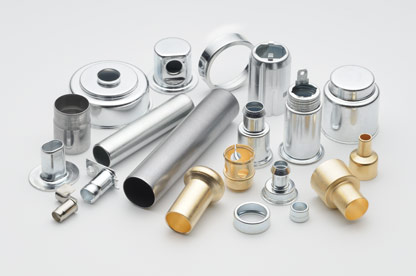
Figure 4 Metal Stamping Products
Consumer Products:
Tools and Hardware: Such as wrenches, screws, and bolts.
Household Items: Including cookware, and furniture components.
Industrial and Manufacturing:
Machinery Components: Gears, levers, and housings.
Conveyors and Handling Equipment Components
Structural Components: For buildings and infrastructure.
Medical Devices:
Surgical Instruments: Bowls, trays, and other tools.
Implants: Plates, screws, and other implantable devices.
Device Enclosures: For medical equipment and devices.
Design Guides
We mainly introduce the main forming steps of metal stamping in this paragraph, where you can learn about the design principles, numbers of ratios, and feature details that need attention during the blanking, punching, bending, piercing, and forming processes.
Blank Profile
Minimum blank thickness should always be more than 1.5mm for all types of materials. Blank corners can be sharp if material thickness is 1.58mm or less. Make your blank corner radii equal to half of material thickness when stock thickness is more than 1.58mm. Slot & tab are another common feature on the blank. Their widths can be no less than 1.5 times of the sheet thickness. The minimum length may vary but can not exceed 5 times of the features width. These design actions will form the basic features of the blanks in one stop and greatly reduce your secondary operation afterward.
Edge Conditions
Edge condition directly related to the clearance between punch and die. The clearance should be in a range of 8% to 10% of the material thickness. If the material sheet gets harder or thicker, it tends to open up the clearance if the material is non-ferrous or relatively soft, a tight punch and die clearance is achievable.
Hole Piercing
If a hole’s diameter is smaller than 1.5 mm, usually piercing will not work. You need secondary operations such as drilling and deburring to manufacture this, that's the lower limit.
When you're piercing holes close to a bend, this distance is equal to 1.5 times of the sum of the stock thickness and the bend's radius. When your part has more than 2 bends in a piece, then you need to process the holes separately
Spacing Between Holes and Other Features
When the length of the adjacent edge is less than 10 times the thickness of the material, the minimum space should be 1.5 times the thickness. On the other hand, if the punched diameter of the hole is less than 5 times the thickness, the space should be twice the thickness.
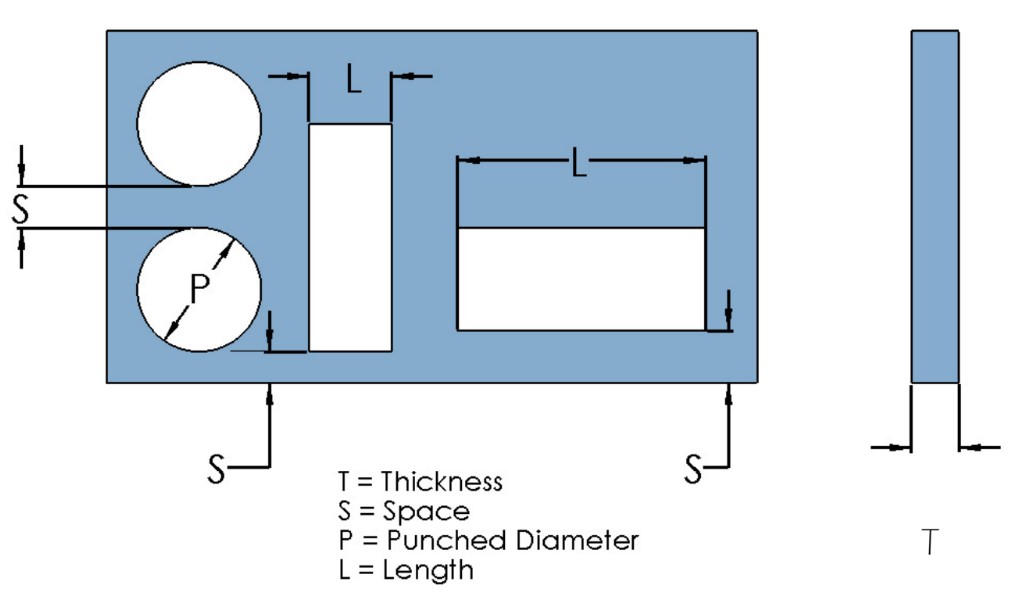
Figure 5 Spacing Between Holes and Other Features
Extruded Holes and Countersink
Extruded hole height is usually 2-3 times of material thickness. Countersinking produces a lower surface or a recess for the head of a fastener in bevel or flare. Most common methods used are formed, shallow and deep swaged.

Figure 6 Extruded Holes
Forming Operation
When the form is inside or close to the blank profile, the material will be cut through, and the center of the bent filet will remain inside the product, which will create concentrated points in the bent area and cause fatigue failure of the product. You should change the blank profile or add slots to provide relief for the bend. The minimum forming height is 2.5 times of the material thickness plus the required bend radius.
You choose the stamping process because it completes as many metalforming as possible in one series of pressing without machining or manual processing. Understanding these contents, you can reduce the massive cost of secondary processing.
Processes of Metal Stamping
There are a series of operations in metal stamping, each operation is responsible for one step of the sheet material forming process. You need to run the part forming in reasonable steps, less steps may cause defects and you cannot form the good part eventually; too many steps let you consume more cost in an unsustainable manufacturing design.
The common forming steps of metal stampings are
Blanking is the first station while metal strips enter the sets of tools. You need to design the outer profile of the parts in a blanking tool so that the metal strips are going to be sheared and have the outline (or at least most of the outline) instantly.
Punching is similar to the blanking process where the flat sheet is created with more features. The main difference is that punching to form the inner features such as holes or slots and whereas blanking more to form the outer profile.
Piercing is another way of creating holes, slots and cutouts on the sheet, which is applicable for complex tool setup, less wastage and higher precision control. Types including lancing, nibbling and shaving etc.
Custom sheet metal bending is making L/U/V shaped angles on the sheet metal in single or multi axis. It uses a die to fixate the sheet, push and press the other side to a certain profile you want. You should consider some design issues such as springback compensation, grain direction to avoid cracking, bend relieving design in case of stress concentration.
Bottom Bending and air bending (as known as coining) are similar bending processes only that the precision and springback are different due to bottoming being seamlessly pressed to the die.
Extrusion forming is a comprehensive process to shape the sheet metal in multiple bends and drawing is specifically making high aspect ratio parts where the thickness is changing during the process.
Flanging is bending the rim and shearing edges after basic forming steps are done, usually you can form the flare for fastening of assembly.
Embossing is not only creating extruded features on the sheets but also changing the texture of the surface, which tends to be used for the 3D raised surface.
Materials Options
You can find hundreds of metals and their varieties used in stamping, the most common applications are aluminum, steel (stainless steel, carbon steel, cold rolled steel ), brass and copper, titanium, etc. We are going to give you a brief introduction of the materials.
Aluminum is lightweight, corrosion-resistant, and has good thermal and electrical conductivity. It's also highly ductile, which makes it easy to stamp. Due to its lightweight and resistance to corrosion, you can use aluminium deep drawing in automotive parts, aerospace components, and packaging such as beverage cans.
Stainless steel is commonly used in kitchenware, medical instruments, and any application where corrosion resistance and aesthetic appearance are important. It is an alloy with at least 10.5% chromium, which gives stainless steel deep drawing manufacturing superior corrosion resistance. It's also strong and can be hardened, which makes it a bit tougher to stamp.
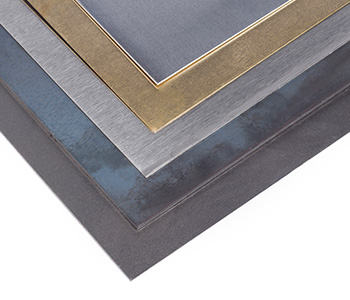
Figure 7 Metal Stamping Materials
Carbon steel has a higher carbon content, which gives it increased hardness and strength, but less ductility. With its cost competitiveness, you can use it as structural components in construction and heavy machinery, and also for automotive parts.
Cold rolled steel is steel that has been rolled at room temperature and it is in a smoother surface finish and increased strength. It's easier to control the dimensions during the stamping process. Cold rolled steel deep drawing is suitable for applications where tolerances, surface, and uniform mechanical properties are important, such as in appliances, furniture, and vehicles.
Brass is an alloy of copper and zinc. Brass metal stamping has excellent machinability, and has a decorative, gold-like appearance. It's also more malleable than bronze or zinc. They are widely used for decorative items, musical instruments, plumbing fixtures, and electrical connectors due to its appearance and electrical conductivity.
Copper is relatively soft, which makes it easy to stamp with excellent electrical and thermal conductivity; you can find copper deep drawing most in electrical components, such as wiring and circuit boards.
Titanium is known for its high strength-to-weight ratio, excellent corrosion resistance, especially the biocompatibility is crucial in medical applications. Its resistance to corrosion and high strength make titanium deep drawing ideal for aerospace, medical implants, and high-performance automotive components.
More material options can be found in stamping industries. You need to tackle strength, formability, functionality and cost altogether to make a successful metal project.
Finishes Options
When your workpiece is fully formed, the appropriate surface finishing process is necessary. This is because you need to remove impurities from the surface, create a visually appealing appearance and texture, and form a protective layer on the surface of the metal material. Below, I will list the common surface finishing processes according to the different characteristics of surface treatment.
Common Uncoated Finishes
Fine polishing can give you a mirror-like, high-gloss finish by abrasion of very fine cloth or hairs.
Buffing produces a smooth, bright finish by a similar process as polishing, but the abrasive tools and media may be different.
Blasting is applied when super hard grits such as sand or iron pits blow to the part surface via a high pressure air gun.
Tumbling, you place parts in a container where abrasive media will grind the parts via high frequency vibration.
Brushing is the same idea of tooth brush yet the brush is made from steel bristle, it can create brush lines with premium looks.
Honing and Lapping are types of unidirectional action to clean or polish the sidewall and flat areas on your parts, acquired by specific machinery.
Chemical Etching is achieved by soaking your parts in a chemical reactive solvent, where the metal atoms are going to be reacted and leave a special texture. You can even have unique patterns by masking treatments.
Laser Engraving or Laser Marking is a common process to leave marks on the surface by laser beam burning.
Common Coated Finishes
Paint is the most common coating process in stamping finishes. Liquid paint applied by spray and cured in a heat oven or UV light to form the even layer of protection.
Powder Coating is a stronger finish which powder paint is electrostatically applied and then cured under heat to form a thick and hard coat.
Electroplating is a process that you can coated with a thin layer of metal under electrical operation, such as zinc, nickel, chrome, or cadmium. However, electroless plating does not operate with electricity but chemically convert metal coating on the subject. Both processes provide an extra metal layer on the part for cosmetic or functional uses.
Anodizing is an electrochemical process that is specialized for aluminum, titanium or magnesium. The surface layers of atoms are oxidized and form a consistent and durable coating under strong electrical baths. You can also produce many colors by adding dye or pigment in the solvent.
E-coat is a painting method where you can dip the metal part in a paint-water mix and electrify it to attract paint onto every surface, coating even the inside as long as the solution touches it. The electric voltage controls the paint thickness.
Galvanizing is where the part is dipped into molten zinc to provide a thick, durable coating for steel parts.
Passivation is a chemical treatment for stainless steel and other metals. It provides a protective oxide layer to reduce the risk of corrosion.
PVD and CVD Coating are vacuum vaporized metallization processes; you can charge the solid metal to a plasma of atoms or particles in an electrical vacuum chamber, depositing them as a high-performance coating. CVD also combines chemical reactions in the deposition.
Tools and Dies
What is Metal Stamping Tool and Die?
When you enter a stamping factory, you may notice the object placed inside the big press machine, it looks full of complex structures and several stations to form the metal sheet step by step. This object is called a metal forming dies and tooling, generally it consists of hundreds of support plates, rod pillars, shaping blocks and accessories to conduct cutting, bending, forming actions for stamping parts. Male pair is the side on extrusion and the female is the concave side, the clearance is where exactly sheet metal is formed and positioned.
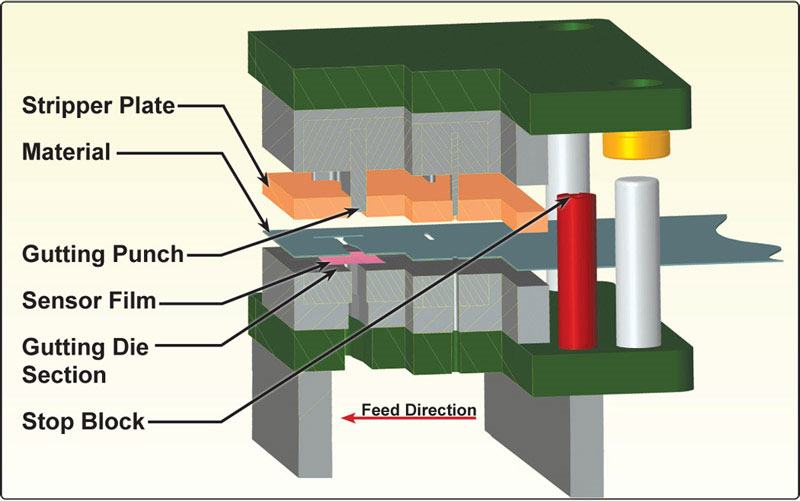
Figure 8 Stamping Tools and Dies
Difference of Tools and Dies
You can regard that tools and die have the same meaning, it is also common sense in this business. But we can still specify the definition as: dies is a kind of tool mostly used in forming but a tool can be a jig, a fixture or placement base not only die for shaping.
Types of Stamping Tools and Dies
The most straightforward way to classify tools is named it single action and multiple actions. Single action tool is considered to operate on step of forming at a time, also called single station or stage tool. However, multiple actions or stations and stages are able to run the forming processes simultaneously, for example, you can blank the strip and punch a hole in the sheet at one station or one movement of the tool.
Single action tools can also be divided to single stamping die and compound stamping die, the main difference is single stamping operates by blanking or piercing simple actions in one press stroke and compound stamping can operate two actions in one stroke of press
Multiple actions tools can be divided into progressive stamping tools and transfer stamping tools. Progressive tools are the most efficient tool sets that can provide continuous high volume output, parts in transfer tools are shaped simultaneously but conveyed by an automatic feeding system, this is a typical difference of transfer tools.
Manufacturing Process
Stamping tools and dies are always considered expensive, that is because the fabrication is complicated and time consuming. Here are some typical manufacturing processes for tools and dies after the design is done
CNC machining: for geometric profile on tool components
Wire EDM: for outer profile of part punching
Heat Treatment: enhance tool steel strength and hardness for long life time
Tool Assembly: final assembly and fitting check before tool installation
Maintenance in Daily Base
Your tool and die need maintenance after being utilized for a period of time or amounts of strokes, else the defect rate will increase dramatically. Here are some major steps of maintenance work:
Tool Steel Options
When you are selecting a tool steel for stamping, you need to think about the sheet material, part shape, tolerance requirement, the volume, and the operating conditions of the stamping press. Tool steel selection is often a balance between toughness and wear resistance. Here are some common tool steel types in the market:
A Series (Air-Hardening, A2, A6, A9, etc.)
D Series (High Carbon-Chromium, D2, D3, etc.)
O Series (Oil-Hardening, O1, O2, etc.)
Cost Breakdown
Metal stamping is very cost competitive compared to machining or 3D printing. However, stamping tools are an important portion of cost overall. A stamping tool’s cost is consist of below items
Tool steel material cost
Tool Fabrication, including machining, coating, heat treatment etc.
Manual operation including design, manufacturing, assembly and inspection
Overhead
Usually your payment is 30% pre-order fee before starting, 50% of payment after first part acceptance, 20% before production, but amortization can be accepted if the production volume is very high.
Types of Stamping Machines
Stamping machines can be divided into many types by their structure and power source. They also focus in different industries due to the cost impact and production consistency, You can find common stamping press in this article
Mechanical press is driven by a motor connected to a mechanical flywheel to transfer energy to the punch.They are common in low volume stamping because of cost-effectiveness.
Hydraulic presses use hydraulic cylinders to generate a compressive force and are preferred for their ability to deliver full force at any point in the stroke. They are stronger in pressing force and able to form hard and thick materials.
Pneumatic presses use compressed air as the power source and are typically used for smaller, low-volume stamping applications.
Servo press is driven by servo motors and combines the advantages of mechanical and hydraulic presses. They offer control over the slide position, speed, and pressure, making them ideal precision and complexity.
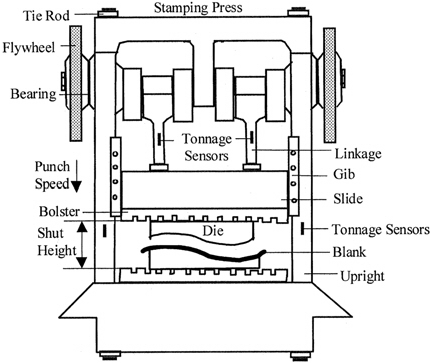
Figure 9 Stamping Machines Structure
What Kind of Production Floor is Metal Stamping Required?
Since stamping equipment is mostly quite heavy, they are often placed on the first floor of buildings. Additionally, their foundations need to be reinforced. Because the central equipment will produce huge impact forces and vibrations during operation, repeated impact forces, if applied to an unstable foundation, can lead to ground cracking or even subsidence, put your safety at serious risks. Moreover, vibrations can severely affect the precision of the products, increasing the wear on the equipment and tools. You need to pay special attention to the construction requirements of the infrastructure to ensure a stable and safe production environment.
Cost of The Metal Stamping
Here we have listed a series of methods that can reduce manufacturing costs for your reference.
Appropriately relax tolerances while meeting product requirements.
Choose materials with a higher cost-performance ratio.
Use more common and standard material specifications.
The clearance between punch and die should be reasonably designed according to requirements; too small a clearance increases costs.
Following the design principles of stamping for good, we can also improve design details to achieve the purpose of reducing costs.
Adjust the bending radius to be approximately equal to the material thickness.
The shape of punched holes should be standardized, especially round holes near edges should have relaxed specifications.
Define the radius of corners for blanking according to design specifications.
Deburring should only remove sharp edges, without specifying exact dimensional requirements.
What Roles are There in a Stamping Project?
In a stamping product project team, there are generally the following work roles:
The product designer will provide the most original product drawings.
The tooling engineer will perform simulation analysis of the mold and design of various components according to the product drawings.
The tool shop will process and assemble parts according to the drawings provided by the tooling engineer.
The production team will carry out trial molding and pilot production to ensure that the tools meet the requirements for mass production.
Quality engineer will establish a complete quality control process according to the requirements of the customer and the production system.
Entire projects from start to finish will involve the participation of project managers, who comprehensively follow up on customer service, evaluate quotations, monitor production progress, and coordinate communication with technical/purchasing/PMC departments.
Pros and Cons
Metal stamping is capable of producing large quantities of components quickly, making it highly efficient for mass production. It is generally a cost-effective process, especially when producing high volumes, due to economies of scale. The stamped parts are highly precise and consistent. Once the tooling is created, each part is stamped to match the exact specifications with very little variation.
Cons
The upfront cost for creating the dies and the tooling needed for stamping can be significant, particularly for complex parts. While metal stamping is quite versatile, it is generally limited to thinner materials. Thick, heavy-duty parts may require alternative methods. Once a die is made, changing the design can be expensive and time-consuming. This makes the process less flexible for short runs of unique parts.
Common Defects You May Aware
You must be aware of various defects that can occur in stamping, such as deformation, springback, ironing, scratches, wrinkles, and fractures. Understanding and addressing these defects is important to ensure the quality of the stamped parts.
Future of Metal Stamping Development
In the future, metal stamping will definitely evolve towards smarter and more efficient directions, with a large introduction of automation equipment, reducing manpower throughout the entire process. You might enter a future stamping workshop and not see many workers; instead, you'll see a lot of robotic arms and human-machine interaction displays.
Moreover, you will encounter a variety of new materials. Scientists and engineers will improve and develop new formulas based on higher requirements and introduce them into production.
Artificial intelligence will also be extensively integrated into actual production. So, you might see AI quality inspectors who can observe the product's appearance and dimensional data through high-precision cameras.
Conclusion
Metal stamping is one of the most important sheet metal forming processes in the industry, you can find basic information about it in this article. Contact us if you have a project needs and we will take care of the manufacturing works from design to delivery.
